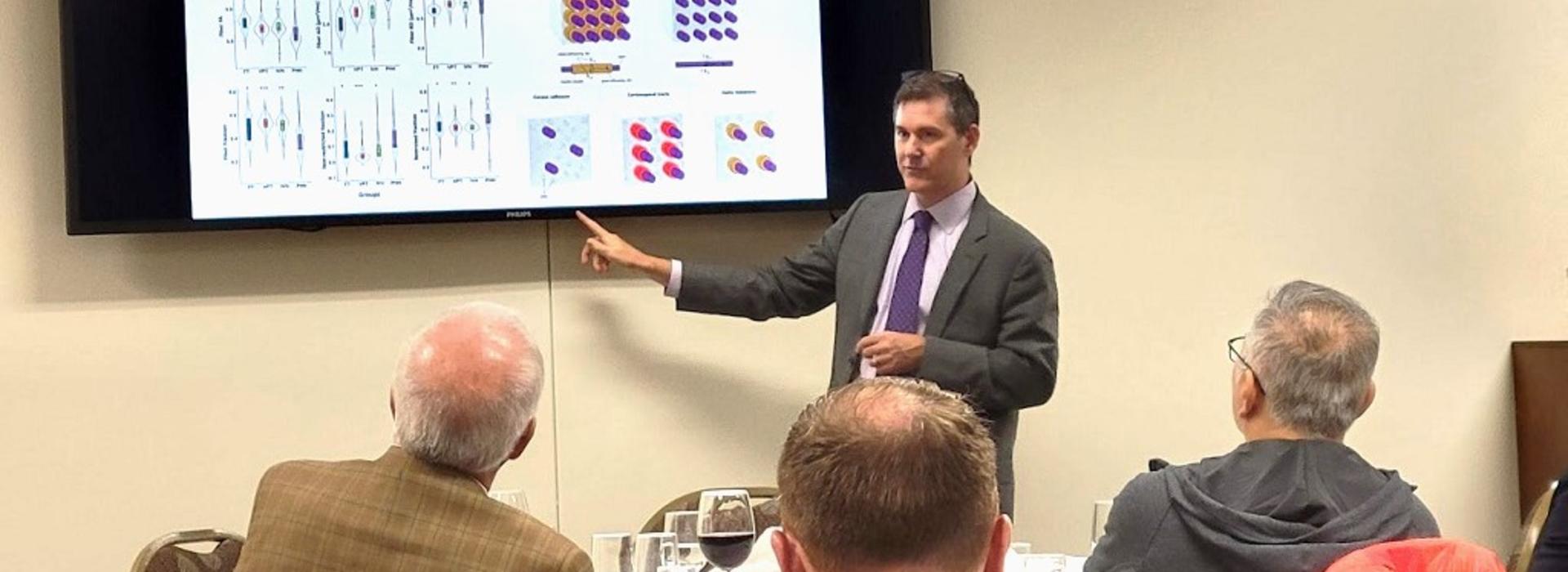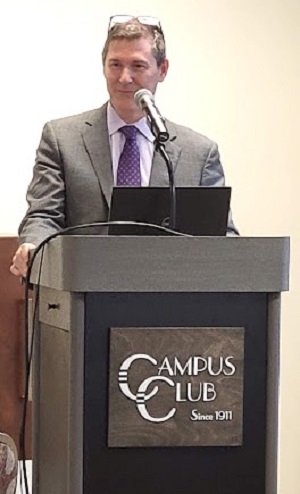
Haines Family Lecturer says life as a trialist neurosurgeon has enabled him to connect more deeply with neurological disease and his patients
In May of 2012, Neurosurgery Department Professor Emeritus Stephen Haines, MD, and his late father, Gerald Haines, MD, PhD, established the Haines Family Lectureship on Clinical Research in Neurosurgery. The lecture series brings in prominent neurosurgeons to interact with faculty and residents and stimulate thought about important topics.
The 2023 lecture, held September 22, at the Campus Club, featured David Limbrick, MD, PhD, Chair of the Department of Neurosurgery at Medical College of Virginia/Virginia Commonwealth University. Limbrick’s presentation was titled, “My Life as a Trialist Neurosurgeon.”
He explained that being a trialist neurosurgeon means that in addition to taking care of patients, he also designs and conducts clinical trials that help develop the best treatments for those patients. “Clinical trials, in many ways, reflect years of work and may have the most direct impact on patient care,” he added. “But I also try to build a framework for understanding the disease in question. As my understanding of diseases has evolved, I feel driven to look at their molecular underpinnings – understanding how the diseases express themselves.”
Right now, Limbrick’s primary areas of investigation focus on two conditions: Chiari malformations and pediatric hydrocephalus. Both endeavors are funded by grants through the National Institutes of Health (NIH) and the Patient Centered Outcomes Research Institute (PCORI) and, as he stresses, reflect the work of many people.

“Team science is real and required for lots of reasons,” said Limbrick (pictured here). “We must think about our patients as multi-dimensional, complex beings and need to understand how our treatments affect not only their condition but them as individuals. Having a team to consider that is really important.”
The other aspect of team science from Limbrick’s perspective is that the sophisticated types of analyses currently required in clinical studies are difficult to master as a single investigator. “Now that we’re integrating molecular genetics with advanced imaging with machine learning and unsupervised clustering…you can’t be an expert in all these things,” he said. “We can only do that kind of work as a team.” Limbrick sees his team members running the gamut from those helping to identify, screen, and enroll patients to final preparation of the results by biostatisticians. “Everyone is critical,” he said.
There is an exciting finding just coming out as a result of Limbrick’s hydrocephalus research. “We know that inflammatory processes underlie the pathogenesis of many diseases,” he said. “When we looked at the cause of post-hemorrhagic hydrocephalus in prematurity, for example, we identified the signaling pathways in cerebrospinal fluid that trigger activation of inflammatory cells throughout the brain and spinal fluid, which in turn, may cause the hydrocephalus.” This type of hydrocephalus is the most common serious neurological complication in premature infants.
Limbrick advises those who have yet to begin their careers as trialist neurosurgeons to have a passion for understanding and identifying the optimal neurosurgical treatment for a neurological problem. “Second, you need to have training in clinical research and clinical trial design,” he said. Limbrick also recommends partnering with experts who have developed the best ways to test the questions in which you’re interested.
“I personally feel that having research or clinical investigation as part of my career has allowed me to feel a deeper connection to the diseases and to the patients I treat,” Limbrick noted. “The work I’ve done throughout my career will enable me to have a lasting impact.”



